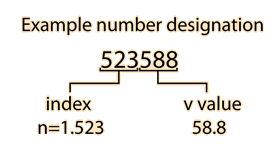Composition of Glasses
Glasses can be considered to be solutions, rather than chemical compounds. According to Meyer-Arendt, about 95% of all glasses are of the "soda-lime" type, containing silicon dioxide (silica), Na2O (soda), and CaO (lime). Crown glass is a soda-lime-silica composite. Flint glasses contain 45-65% lead oxide - they are high-density, high-dispersion, high-refractive-index glasses. There are glasses which have barium oxide rather than lead oxide; they are called barium glasses. Barium glasses have refractive indices comparable to the flints, but have lower dispersions. Other heavy elements are used to make flint glasses, such as lanthanum and the rare earths.
As alternatives to silica glasses, other "glass formers" such as boron oxide (B2O5), phosphorus pentoxide (P2O5) and germanium oxide (GeO2) can be used.
|
Index
Lens concepts |
